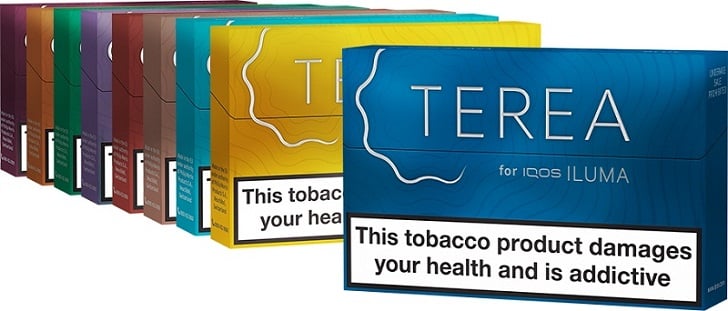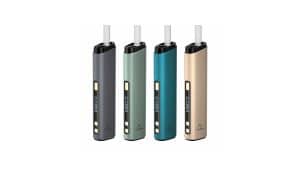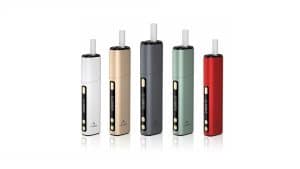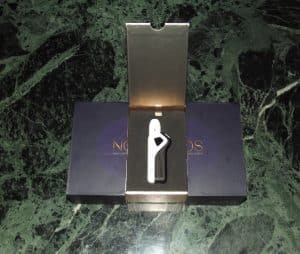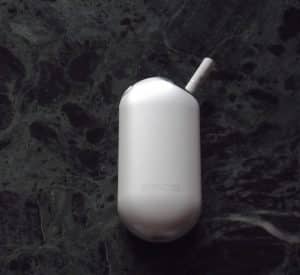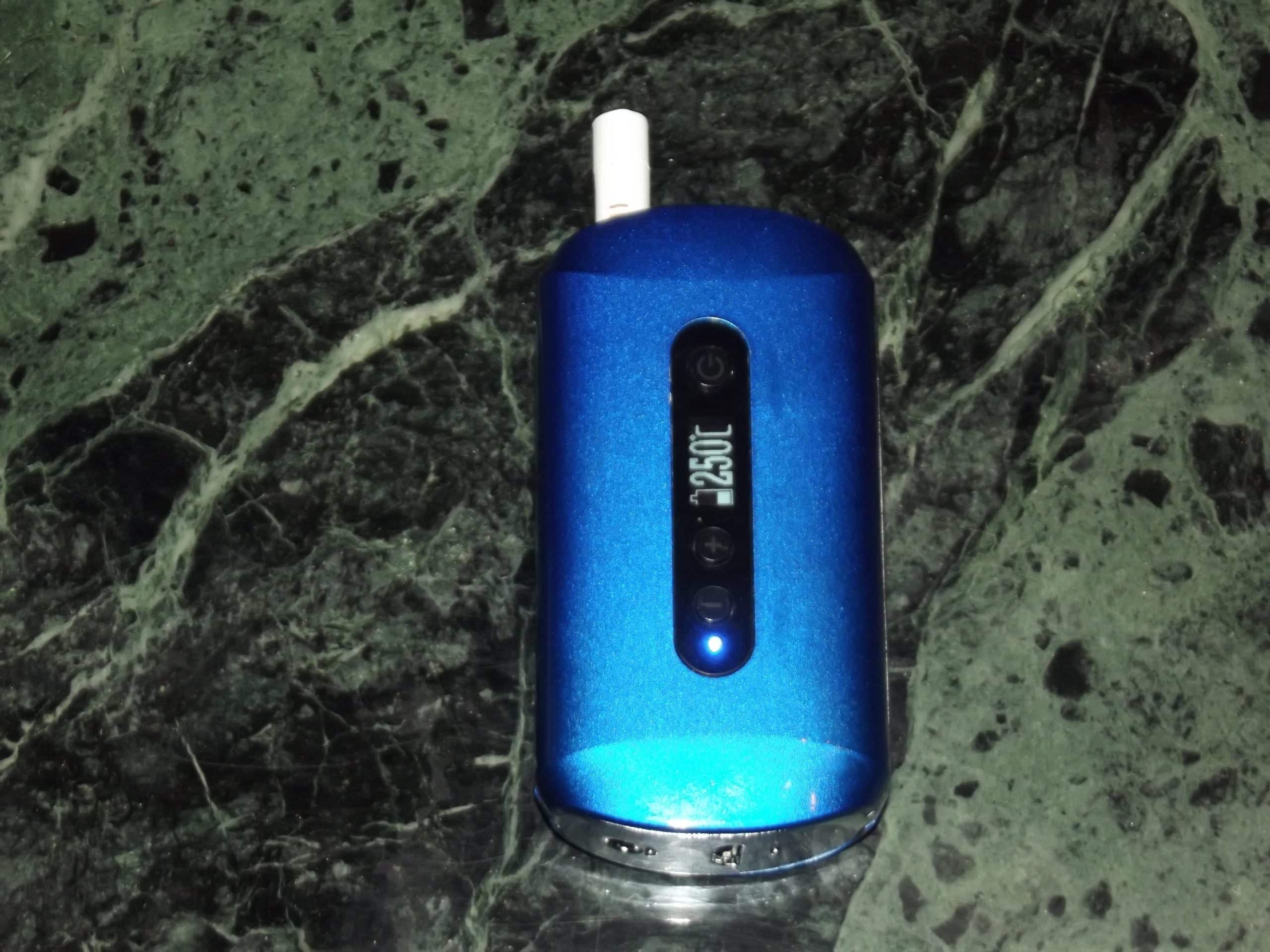
So, it’s that time again. The postman delivered a parcel from China last week, I’ve been playing with a new gadget since then, and now it’s time to give all you Heat not Burn fans the inside scoop on the latest and greatest (well, we’ll see about that) in tobacco vaporisation technology.
This time, my new toy is the VCOT from Ewildfires. It’s the latest product from Shenzhen, the Chinese industrial region that’s become the global hub of e-cigarette manufacturing and is now trying to grab a foothold in the HnB market as well. We’ve already reviewed a few devices from Chinese companies – the iBuddy i1, EFOS E1 and NOS – and a couple of them were pretty impressive. So how does the VCOT stack up?
The Review
The VCOT is brand new – so new that I’m not going to go through the traditional unboxing experience. The retail packaging hasn’t even been designed yet, so my review sample turned up in a plain cardboard box and a nest of bubble wrap, with no accessories. There wasn’t even an instruction manual; that arrived by email. It wouldn’t be fair to comment – or even speculate – on packaging and accessories that I haven’t seen, so for this review I’ll only be looking at the vaporiser itself.
As I said, the VCOT is brand new, and its designers have obviously tried to push the technological envelope a bit. Like the NOS we looked at a few weeks ago it’s a temperature-controlled device that lets you set the operating temperature to get the vape you want.
So if the body is all metal, how come the device is so light? The answer is that the metal is very thin. The front and back are stamped out of sheet. I don’t know what the sheet is, but it isn’t steel – I couldn’t get my neodymium supermagnets to stick to it. It could be aluminium; the glossy, deep blue finish looks like it could be anodised.
Unfortunately, the thin metal gives the VCOT a slightly flimsy feel. If I squeeze the body between finger and thumb it flexes slightly and lets out a chorus of creaking and clicking sounds. Shaking it isn’t reassuring either; something – probably the battery pack – rattles around inside. That isn’t just an annoyance, because if things are free to move it increases wear and tear on wiring, so the device is more likely to fail (more on that later).
All the work is done at the front of the device, on an inlaid black plastic panel. At the top of this is the power button, and at the bottom the temperature up/down buttons and a blue LED to show current status. In between the buttons is a 0.7” OLED screen, which gives a nice clear, bright image.
So, on build quality, the VCOT isn’t really up to the standard of the other devices I’ve reviewed. Even the plastic-bodied EFOS has a much more solid feel to it. On the other hand the VCOT does pack in a 2,200mAh battery, which hints at good battery life, and it has the advantage of temperature control. If a gadget performs well I can easily overlook a creaky casing. So how does the VCOT stack up when it comes to actually vaping?
Vaping the VCOT
Putting a full charge in the VCOT takes about an hour, which is pretty reasonable, and you’ll know when it’s done – the LED on the front blinks brightly while it’s charging, and the battery indicator on the screen makes it easy to see how much progress you’re making. When the LED and screen switch off it’s fully charged and ready to go.
Loading the VCOT is pretty simple; all you have to do is slide the cover back and push the tobacco end of the Heet into the heating chamber. This has to be done carefully though, as there’s a bit of resistance for the last half inch. With no blade or spike to force into the tobacco, this turns out to be because the heating chamber is a tighter fit than the EFOS. Still, I managed to get all my Heets in without breaking them, so it’s not a major problem.
With a stick in the chamber you can now turn the VCOT on by pressing the power button five times. I think I’ve already vented my feelings about this; a single long press on the button is just as resistant to accidental activation, and these microswitches won’t last an infinite number of presses. Again, though, this isn’t a big deal.
Once the device turns on you’ll see the temperature readout on the screen start to rise. While it’s heating up you can use the up and down buttons to adjust it to the temperature you want. The temperature range is from 220-250°C, which seemed a bit on the low side; iQOS runs at 350°C, and when I played with the NOS a few weeks ago it was happiest between 320°C and 335°C. The VCOT seemed to be pitched a little low, but as it turned out this wasn’t really an issue.
Here’s something that was an issue; it takes forever to heat up. Our current champ in that respect is the NOS, which went from room temperature to 325°C in a mere nine seconds. The VCOT took just over a minute (61 seconds, to be precise) to show 250°C on the display, and that just isn’t good enough. Then it kept me hanging on for another 20 seconds before it buzzed to tell me it was ready to vape.
The vape’s OK, if you set it to 250°C.
A few little issues
A vaping session on the VCOT lasts for three minutes and 30 seconds. When your time’s up it simply buzzes and switches off; there’s no warning to give you time to grab a last puff. Then it’s time to take out the used Heet – and that’s where the fun really begins.
With most of the HnB devices I’ve tested (the Glo and NOS are honourable exceptions) I’ve had the occasional stick leave its plug of tobacco behind in the chamber. This is mildly annoying, but no big deal; you can easily take the top of the device apart and dig out the debris with a brush.

With the VCOT, about half the Heets I used broke off at the joint between the tobacco plug and the hollow section above it. The first time this happened (which was also the first Heet I vaped with it) I found, to my annoyance, that there’s no way to dismantle the device for easier access to the chamber. I had to resort to digging out the tobacco with a bit of wire, then using a brush to clear the remaining debris.
Examining this debris, and the Heets I managed to extract in one piece, was interesting. The display might say 250°C, but the inside of the chamber is getting hot enough to char the Heet’s paper tube quite badly – and, a lot of the time, it’s burning it to ash. That seems to be why so many of them break; the paper disintegrates and lets the foil liner stick to the wall of the chamber. The actual tobacco isn’t burned, like it was with the EFOS, but I’m still not convinced this is really in the Heat not Burn spirit.
I also found that, sometimes, the VCOT just doesn’t work. I’d press the button five times, the display would light up, then the temperature readout would stick at either the high 20s or the high 40s. If I left it alone, an error message would flash up on the screen – “CHECK FPC!” – or it would just turn itself off. After some fiddling I found that sometimes pulling out the Heet would unblock it; the temperature would start to rise, and I could put the Heet back in and wait for it to reach operating temperature. Other times I had to plug in the charging cable briefly, which seemed to reset it, then I could power it back up again.
Conclusions
I’m conscious that this is a pre-release device, so I don’t want to be too hard on it. The VCOT has some potential. It’s compact and has decent battery life – a full charge will see you through a pack of Heets and maybe a little more. The vape is acceptable at the higher end of the temperature range. If it’s priced appropriately it could be a reasonable choice for those on a budget – as long as these points are fixed:
- The heating chamber needs to be made slightly larger; it’s too tight. With no way to dismantle the device for cleaning, its tendency to tear the ends off used Heets isn’t acceptable.
- Heat up time needs to be radically reduced, to 20 seconds or less. More than a minute is simply not good enough.
- Reliability needs to be improved. I expect a device like this to work properly every time I switch it on. The VCOT doesn’t.
- Whatever’s rattling around inside needs to be fixed in place. Any movement risks weakening, and eventually breaking, soldered joints. Is this the cause of its unreliability? Could be.
Deal with all these issues and, as I said, the VCOT might have some potential. It does have temperature control and its battery life is better than the NOS, so there are a couple of positives there. However, right now I just can’t recommend it. Get an iQOS instead.

